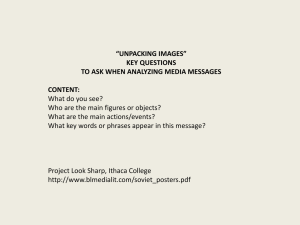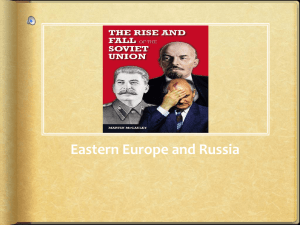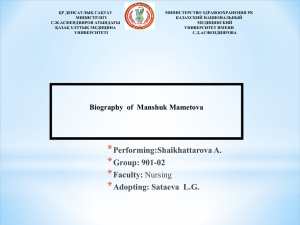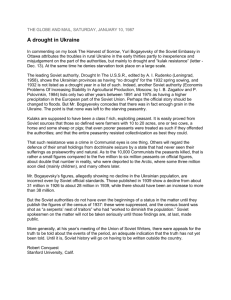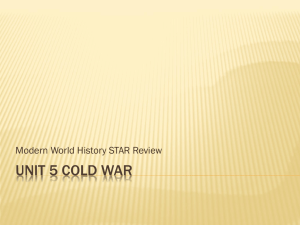`The Transnational Activism of British human rights organisations
advertisement
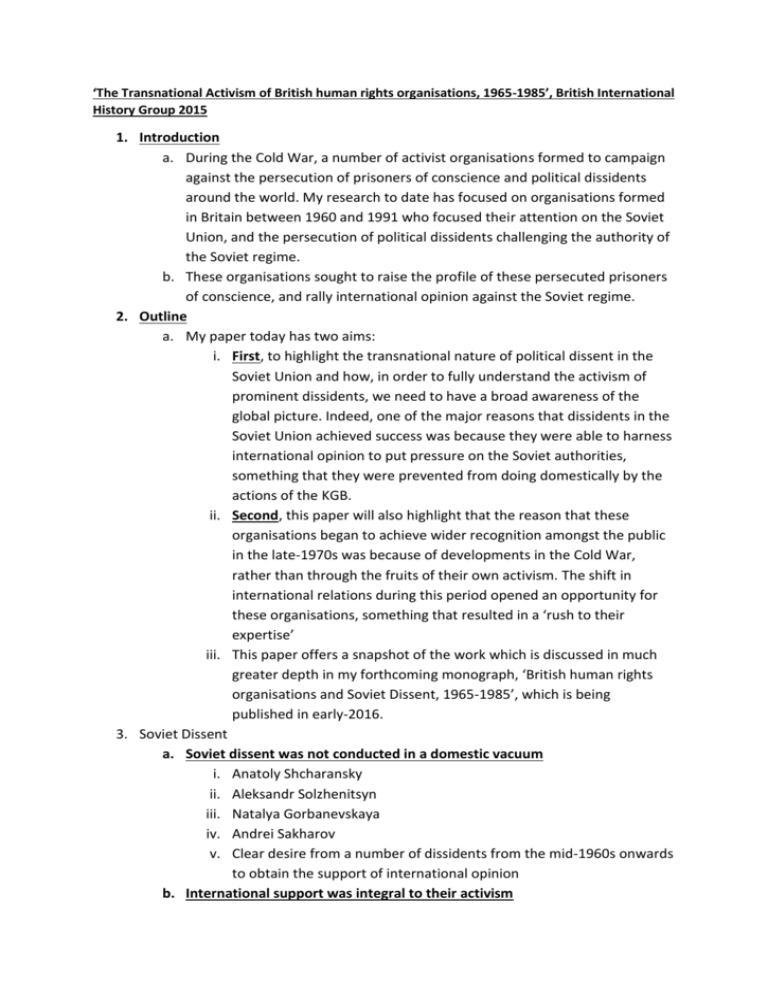
‘The Transnational Activism of British human rights organisations, 1965-1985’, British International History Group 2015 1. Introduction a. During the Cold War, a number of activist organisations formed to campaign against the persecution of prisoners of conscience and political dissidents around the world. My research to date has focused on organisations formed in Britain between 1960 and 1991 who focused their attention on the Soviet Union, and the persecution of political dissidents challenging the authority of the Soviet regime. b. These organisations sought to raise the profile of these persecuted prisoners of conscience, and rally international opinion against the Soviet regime. 2. Outline a. My paper today has two aims: i. First, to highlight the transnational nature of political dissent in the Soviet Union and how, in order to fully understand the activism of prominent dissidents, we need to have a broad awareness of the global picture. Indeed, one of the major reasons that dissidents in the Soviet Union achieved success was because they were able to harness international opinion to put pressure on the Soviet authorities, something that they were prevented from doing domestically by the actions of the KGB. ii. Second, this paper will also highlight that the reason that these organisations began to achieve wider recognition amongst the public in the late-1970s was because of developments in the Cold War, rather than through the fruits of their own activism. The shift in international relations during this period opened an opportunity for these organisations, something that resulted in a ‘rush to their expertise’ iii. This paper offers a snapshot of the work which is discussed in much greater depth in my forthcoming monograph, ‘British human rights organisations and Soviet Dissent, 1965-1985’, which is being published in early-2016. 3. Soviet Dissent a. Soviet dissent was not conducted in a domestic vacuum i. Anatoly Shcharansky ii. Aleksandr Solzhenitsyn iii. Natalya Gorbanevskaya iv. Andrei Sakharov v. Clear desire from a number of dissidents from the mid-1960s onwards to obtain the support of international opinion b. International support was integral to their activism i. 1974 Jackson-Vanik Amendment – Directly linked the plight of Soviet Jewry to the Most Favored Nation trading status that the Soviet authorities craved ii. 1975 Helsinki Accords c. Developments in the West, however, were a little slower. I’d like to look at this through the response to a number of different facets of the Soviet abuses. 4. Psychiatry a. First awareness of the political abuse of psychiatry in the Soviet Union in 1965 i. Valery Tarsis - Ward 7 (May 1965) 1. Publication of semi-autobiographical account of detention in a psychiatric institution. 2. Serialised in the Guardian, first real discussion of the issue in Britain that attracted the attention of activists. Truth of the story reasserted by the case of ii. Evgeny Belov (October 1965) 1. 4 British students visit him 2. Return a year later, disappeared into psychiatric institutions after criticising the regime 3. Began campaign on his behalf in Britain. Relatively well reported, but lacked widespread support b. Petro Grigorenko (late-1960s) – relative lack of reporting c. Zhores Medvedev (1971) – increased levels of reporting, but still limited (possibly due to the short incarceration) d. 1972 Bukovsky Documents i. Led to the creation of the Working Group on the Internment of Dissenters in Mental Hospitals ii. But largely overlooked by the international psychiatric community iii. Soviet responses to the reports of abuse were a complete dismissal of the accusations. iv. Only following the Bukovsky exchange for the Chilean Communist Leader Luis Corvalan in December 1976 that things change. This event was an admission by the Soviet Union that it held political prisoners, something that it had vehemently dismissed in previous years. v. World Psychiatric Association World Congress in 1977 in Honolulu takes the matter much more seriously 1. Declaration of Hawaii 2. Formation of WPA Review Committee vi. Eventually leads to the Soviet AUSNP resigning from the WPA in the weeks leading up to its 1983 World Congress in Vienna when rising international pressure indicated that it would be expelled from the organisation. 5. Soviet Jewry Campaigns a. Similar trajectory in the campaigning efforts for Soviet Jewry. b. Early-1970s based on gaining media attention for the refuseniks, Soviet Jews who had been refused the necessary permissions to emigrate and were persecuted for their requests to leave. c. Initial campaigns led by groups such as the Women’s Campaign for Soviet Jewry (nicknamed the 35’s) in the early 1970s focused on drawing attention to this issue using colourful demonstrations – often with lots of fancy dress. d. Much of this was supported by the refuseniks themselves, who assisted the work of these groups once been released – perhaps most notably in the case of Avital Shcharansky who led a large campaign on behalf of her husband Anatoly, who was refused permission to leave. e. From the mid-1970s onwards, the tactics of these groups changed to focus on obtaining the support of those in political power (Politicians, Trade Unions etc.) f. Highlights that their cause was no longer ephemeral as it had been in the early-1970s, but a genuine political concern in the late-1970s that group’s such as the 35’s sought to influence, rather than promote. This, much like the political abuse of psychiatry, was due to concern for the plight of Soviet dissidents becoming a salient political issue in this period rather than, in my opinion, the explicit efforts of Soviet Jewry organisations. 6. Keston College a. An international perspective was also central to the work of Keston College, an organisation founded in the early-1970s by Michael Bourdeaux to ‘be the voice’ of the persecuted religious believer in the Soviet bloc. His activism was focused on the collation of an archive of underground samizdat materials from persecuted believers in order to build up a picture of life behind the iron curtain. These materials were then used to create an array of publications documenting the Soviet persecution of religion. b. Early publications produced by those affiliated to Keston College, such as Bourdeaux’s Opium of the People, failed to have the impact that he had hoped for, and was arguably largely overlooked. c. However, much like psychiatric organisations and the campaigns for Soviet Jewry, the broader successes of Keston College was dependent on the climate in international relations being right for its work, something that occurred in the mid-to-late-1970s when the group went from being on the fringes of political society to the centre stage, something that culminated in Bourdeaux being involved in the ‘Chequers seminars’ initiated by Thatcher in 1984 to develop her awareness of the Soviet Union. 7. Amnesty a. Discussion of human rights organisations in Britain in this period would be incomplete without discussion of the work of Amnesty International b. Despite the group’s desire to remain impartial in the context of the Cold War, it was anything but in its dealing with Soviet prisoners of conscience. c. In fact, it could be argued that Amnesty became an extension of the dissident movement through its reproduction of the Chronicle of Current Events in an English translation. i. The Chronicle was an underground journal concerned with documenting the situation in the Soviet Union. ii. Impartiality of the Chronicle iii. Despite this, it was still a dissident publication iv. Amnesty attempted to distance itself from the Chronicle on a number of occasions, including obtaining an agreement by Writers and Scholars International (the group behind Index on Censorship) to produce the Chronicle. However, given Amnesty’s reputation WSI’s publication was produced in Amnesty’s name. v. Amnesty’s support for the Chronicle also offered a sense of protection for dissidents in the Soviet Union, who were aware that Western production of material about their position prevented the Soviet authorities from the most brutal of attacks. vi. This in turn raised Amnesty’s profile in the Soviet Union, to the extent that a collection of dissidents formed an Amnesty group in Moscow, further blurring the lines between Soviet dissident and Western activist. d. Amnesty’s reputation in the mid-1970s is a really good indication of the rising profile of human rights issues in this period, highlighting how it is easy to overlook the transition that occurred. i. Amnesty awarded 1977 Nobel Peace prize, heralded by the group as a moment when its work was widely recognised. ii. The reality, however, is a little murkier. iii. As there was no peace prize awarded in 1976 there were two awards in 1977 – to Amnesty and the founders of the Ulster Peace Campaign Mairead [ma-raid] Corrigan and Betty Williams. iv. The news coverage following the award, however, focused entirely on the award to Corrigan and Williams v. Example of the Mirror Front Page and p. 3. vi. The Daily Express wasn’t much better – in full The 1977 Nobel Peace Prize went to Amnesty International, London-based, which works for political prisoners around the world and against torture. “We are,” said secretary-general Mr Martin Ennals, “delighted” vii. This was echoed across the British press, with the Observer later noting how much this lack of coverage had demoralised Amnesty’s researchers. e. Important to note that human rights concerns, even presented by groups that currently maintain a high status such as Amnesty, were not always a major political issue 8. The Rush to Expertise a. 1960s – Establishment of expertise b. Mid-1970s – recognition of activists work c. Late-1970s onwards – Expansion of activists’ work 9. Conclusion a. Need to understand Western activism alongside developments in the Soviet Union – they are absolutely intertwined. b. Cold War developments are integral to the developing political salience of human rights. As a result, the successes of activist groups in Britain were dependant on conditions in international relations. Following the major events of the mid-1970s, including the end of the Vietnam War and the signing of the Helsinki accords, human rights becomes an important issue. As a result, there is a ‘rush to the expertise’ that activists had developed on the issue over the preceding decade by journalists and politicians alike c. This all has ramifications for the current crop of political activists in Russia, who are utilising Western Support as a part of their activism against Putin’s government (in the case of Pussy Riot) or conducting activism that is drawing the attention of the international community (in the case of Petr Pavlensky). d. While the actions of these individuals are being widely reported in the West, it will only be when conditions in international relations are right that the campaigns on their behalf will gain political traction and, like their counterparts in the 1970s, will rise to prominence.
